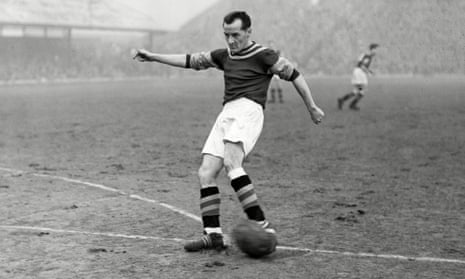For four years in the 1950s, Jackie Sewell, who has died aged 89, was the most expensive footballer in Britain, having moved from his first league club, Notts County, to Sheffield Wednesday for a record £34,500 midway through the 1950-51 season.
A quick, clever and incisive inside-forward, Sewell scored half a dozen First Division goals in 10 games, which almost saved Wednesday from relegation; they eventually went down by the narrowest of margins, on goal average. The following season he scored 22 goals in 35 Second Division matches to bring them back up to the top flight, and his feats with Wednesday earned him his first England call-up, against Ireland in November 1951. The next summer he scored England’s first goal in a famous 3-2 friendly victory over Austria. Yet he would win only six international caps in all, and his misfortune was that two of them came against the brilliant Hungarians, who thrashed England 6-3 at Wembley in November 1953 and 7-1 in Budapest the following May. He was the last surviving member of the England team from the 1953 Hungary game.
At Wembley, where he played inside-left, he dashed through the Hungarian defence to score a fine first-half goal that brought the score to 1-1 and gave England brief, illusory hope. “We were going to win,” he later told me. “There was no doubt about that, because we hadn’t been beat at home. But the only chance I think I had all afternoon was when I scored.”
His final England goal tally was three, but he continued to produce goals frequently for Wednesday, although in 1954-55 his 14 in 35 games could not save them from another relegation. With 13 goals in 16 games the following season he materially helped them to regain their First Division place, but midway through the campaign he was sold to Aston Villa. He stayed with them until early in the season 1959-60, figuring in the Villa team that won the FA Cup 2-1 against Manchester United in 1957.
Born in Whitehaven, Cumbria, Sewell left school to become a milkman, but soon switched to working down the mines so that he could be free at weekends to play football for his local club, Kells Centre, following in the footsteps of his father and half a dozen uncles.
Gifted but sometimes unpredictable on the field, he was only 15 when Frank Buckley, the celebrated manager of Wolves in prewar years, brought him to Notts County. He won a regular place in County’s Third Division (South) side in the 1946-47 season, making an immediate impact with 21 goals in 37 games. The following season the veteran former England centre-forward Tommy Lawton arrived at the club from Chelsea, and the two of them formed an outstanding partnership. In 1949-50, playing alongside Lawton, Sewell’s 19 goals in 32 games helped the team to promotion to the Second Division, where in the following campaign, clearly untroubled by better opposition, he added another 14 goals in 26 games, before Sheffield Wednesday came calling. He was, he said, perfectly happy at Meadow Lane, and had no great desire to join a bigger, richer club. But the transfer went ahead nonetheless. The £34,500 transfer fee was, briefly, a world record: no bigger sum was paid for a player in Britain until Eddie Firmani was sold by Charlton to Sampdoria for £35,000 in 1955. Not until Alan Shearer went from Blackburn Rovers to Newcastle United for £15m in 1996 did a British player command a world-record transfer fee again.
Nat Lofthouse of Bolton Wanderers, the England centre-forward, was among Sewell’s admirers and friends, striking up a fine understanding with him when they both played for England. “His real value was never appreciated,” said Lofthouse. “We hit it off because we were totally different. I couldn’t play, but I could shoot and head. Jackie could play. He had great skill, positional sense and an ability to spot an opening.”
When Sewell went to Villa for £20,000, he renewed his acquaintance with their manager, Eric Houghton, once a teammate at Notts County. He had a successful, if fairly short, spell at Villa Park, making 123 league appearances and taking possession of his only winner’s medal, for the FA Cup, before transferring to Hull City for a mere £2,000 in 1959. When he finished at Hull two years later, with 509 English league appearances and 228 league goals from his 15-year career, he went off to what was then Northern Rhodesia as a coach and player for the Lusaka club. Northern Rhodesia became Zambia in 1964, and in his late 30s Sewell was chosen to play 10 times for the newly independent nation during 1964-65, captaining the side and becoming one of the few footballers to have played for two different countries.
He later coached teams in Zimbabwe and Zaire (now the Democratic Republic of Congo) before retiring to Nottingham, where he was a regular attender at Notts County matches into old age.
His wife, Barbara, died in 2010; he is survived by their son, Paul.

Comments (…)
Sign in or create your Guardian account to join the discussion